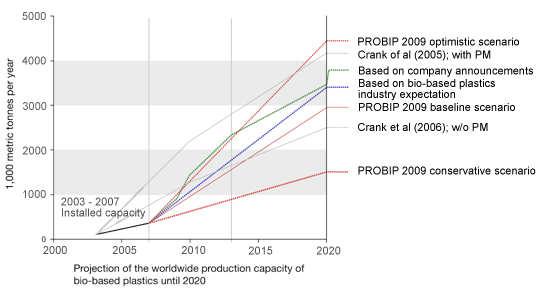Potential for upto 90% substitution of total plastics consumption by biopolymers is technically possible. The associations European Bioplastics and the European Polysaccharide Network of Excellence (EPNOE) published a jointly commissioned study on bio-based plastics, focusing on forecasts concerning capacity developments and technical substitution. How fast this substitution will occur depends on a multitude of factors.
New bio-based polymers have been available in the market for approximately one decade. Recently, standard polymers like polyethylene, polypropylene, PVC or PET, but also high-performance polymers like polyamide or polyester have been totally or partially substituted by their renewable equivalents. The starting raw materials are usually sugars or starches, partially also recycled materials from food or wood processing. The study demonstrated that up to 90% of the current global consumption of polymers can technically be converted from oil and gas to renewable raw materials. Bio-based plastics will not substitute oil-based polymers in the near future for several reasons including low oil price, high production cost and restricted production capacity of biomass-based polymers that limit the technically possible growth of these plastics in the coming years.
Based on recent company announcements, the production capacity of bio-based plastics is projected to increase from 360,000 tons in 2007 to about 2.3 mln tons by 2013. This corresponds to an annual growth of 37%. Important major projects were delayed in the years 2008 and 2009 due to the financial and economic crisis. The role that lightweight conventional plastics played in the past, substituting durable materials like iron and steel in vast products, could soon be taken over by bio-based plastics.
Three scenarios are distinguished to establish potential future growth trajectories, i.e. a baseline scenario, an optimistic and a conservative scenario. The results for these scenarios are also compared to the findings of a previous study made in 2005. The new study confirms that substantial technological progress has been made in bio-based plastics in the past five years. Innovations in material and product development, environmental benefits as well as the gradual depletion of crude oil increasingly call for polymers made from renewable raw materials.

Bioplastics will raise more than fourfold to 900,000 metric tons in 2013, valued at US$2.6 bln, according to a report by The Freedonia Group. The growth will be fueled by a number of factors, including consumer demand for more environmentally-sustainable products, the development of bio-based feedstocks for commodity plastic resins and increasing restrictions on the use of nondegradable plastic products, particularly plastic bags. Most important, however, will be the expected continuation of high crude oil and natural gas prices, which will allow bioplastics to become more cost-competitive with petroleum-based resins. Non-biodegradable plant-based plastics will be the primary driver of bioplastics demand, posting extraordinary growth from a small 2008 base. In the next few years, Braskem and Dow Chemical each plan to open plants in Brazil that will produce polyethylene from sugar cane-based ethanol, while Solvay is expected to open a bio-based polyvinyl chloride facility. Biodegradable plastics, such as starch-based resins, polylactic acid (PLA) and degradable polyesters, accounted for the vast majority (nearly 90%) of bioplastics demand in 2008. Double-digit gains are expected to continue going forward, fueled in part by the emergence on the commercial market of polyhydroxy-alkanoates (PHAs). PLA will also see strong advances in demand as new production capacity comes online. Western Europe was the largest regional market for bioplastics in 2008, accounting for about 40% of world demand. Bioplastics sales in the region benefit from strong consumer demand for biodegradable and plant-based products, a regulatory environment that favors bioplastics over petroleum resins, and an extensive infrastructure for composting. Demand will grow more rapidly in the Asia/Pacific region, which will surpass the West European market by 2013. Gains will be stimulated by strong demand in Japan, which has focused intently on the replacement of petroleum-based plastics. Other regions, such as Latin America and Eastern Europe, will see stellar gains in bioplastics demand from a very small 2008 base.
|
|